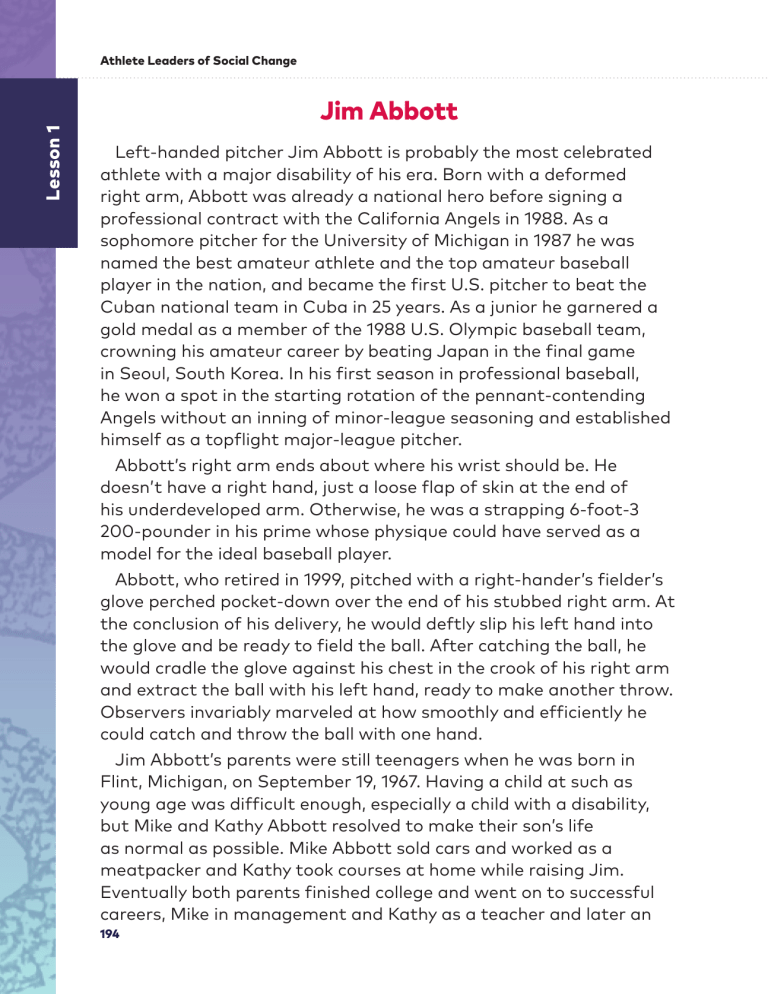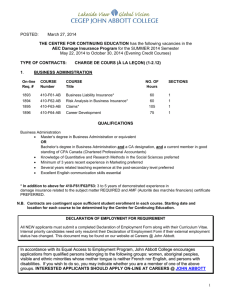
Lesson 1
Athlete Leaders of Social Change
Jim Abbott
Left-handed pitcher Jim Abbott is probably the most celebrated
athlete with a major disability of his era. Born with a deformed
right arm, Abbott was already a national hero before signing a
professional contract with the California Angels in 1988. As a
sophomore pitcher for the University of Michigan in 1987 he was
named the best amateur athlete and the top amateur baseball
player in the nation, and became the first U.S. pitcher to beat the
Cuban national team in Cuba in 25 years. As a junior he garnered a
gold medal as a member of the 1988 U.S. Olympic baseball team,
crowning his amateur career by beating Japan in the final game
in Seoul, South Korea. In his first season in professional baseball,
he won a spot in the starting rotation of the pennant-contending
Angels without an inning of minor-league seasoning and established
himself as a topflight major-league pitcher.
Abbott’s right arm ends about where his wrist should be. He
doesn’t have a right hand, just a loose flap of skin at the end of
his underdeveloped arm. Otherwise, he was a strapping 6-foot-3
200-pounder in his prime whose physique could have served as a
model for the ideal baseball player.
Abbott, who retired in 1999, pitched with a right-hander’s fielder’s
glove perched pocket-down over the end of his stubbed right arm. At
the conclusion of his delivery, he would deftly slip his left hand into
the glove and be ready to field the ball. After catching the ball, he
would cradle the glove against his chest in the crook of his right arm
and extract the ball with his left hand, ready to make another throw.
Observers invariably marveled at how smoothly and efficiently he
could catch and throw the ball with one hand.
Jim Abbott’s parents were still teenagers when he was born in
Flint, Michigan, on September 19, 1967. Having a child at such as
young age was difficult enough, especially a child with a disability,
but Mike and Kathy Abbott resolved to make their son’s life
as normal as possible. Mike Abbott sold cars and worked as a
meatpacker and Kathy took courses at home while raising Jim.
Eventually both parents finished college and went on to successful
careers, Mike in management and Kathy as a teacher and later an
194
Grade 5: Module 3: Unit 3: Lesson 1
attorney. Jim’s parents always encouraged him to try things and
helped him acquire confidence. “We decided that if Jim wanted to
[play sports] then to let him try,” said Mike Abbott in a 1998 USA
Today interview. “I helped out with some things. But in the end it was
all Jim. It had to be.”1
Jim started showing an interest in sports at an early age. Trying
to nudge him toward a sport that didn’t depend on the use of his
hands, his parents bought him a soccer ball. But, Jim didn’t really
like soccer. After all, every other kid in the neighborhood was playing
baseball so that’s what he wanted to do. Ironically, it was Jim’s
younger brother, Chad, who became a soccer player.
So Jim Abbott began developing the remarkable hand-eye
coordination that would allow him to do with one hand what others
did with two. He spent hours throwing a rubber ball against a brick
wall and catching it on the rebound. His father helped him develop
the technique for handling his glove-hand switch which allowed
Jim him to throw and catch the ball with the same hand. Over the
years he continued this drill, moving closer and closer to the wall and
making the glove transition faster and faster.
When Jim began school, he was fitted with a mechanical hand
made of fiberglass and metal. But he hated the prosthesis, which
he called a “hook,” because it frightened some of his classmates and
made him self-conscious. Eventually his parents stopped making him
wear it.
At the age of 11, Jim joined a Little League team and threw a
no-hitter in the first game he pitched. Despite his early success, most
people figured the competition would soon pass him by. In fact, at
every step, from Little League on, he kept hearing that his playing
days would probably end at that level. But at each new level, Jim
proved his doubters wrong. When he entered high school at Flint
Central, his new coach doubted Jim would be able to defend his
position adequately. But Jim actually fielded well enough to play first
base and the outfield when he wasn’t pitching.
1 Tim Wendel, “Return Engagement: After sitting out a year, Jim Abbott makes an improbable
comeback.” USA Today Baseball Weekly, September 9-15, 1998
EL Education Curriculum
195
Lesson 1
Athlete Leaders of Social Change
Even his hitting was exceptional. Jim batted from the left side,
wrapping his left hand around the bat and the stub of his right arm.
He was able to generate remarkable power, blasting seven homers
and batting an excellent .427 as a senior. On the mound that year he
won ten games and lost three with an incredibly low 0.76 ERA and
averaged more than two strikeouts per inning pitched.
Jim was also the backup quarterback for Flint Central until the
end of his senior year when he started the last three games, passing
for 600 yards and six touchdowns. In addition, he was the squad’s
punter, averaging 37.5 yards per kick as a senior. His first national
exposure came when his high school football accomplishments were
featured on NBC’s The NFL Today pregame show.
Abbott was drafted by the Toronto Blue Jays out of high school in
the 36th and last round of the draft, but turned down their $50,000
bonus offer to attend the nearby University of Michigan. Despite
the major league offer and his high school achievements, colleges
with top baseball programs didn’t heavily recruit him. There were
still some reservations about his disability, and Abbott himself
admitted to having some initial doubts about his ability to play
college baseball. But they were quickly dispelled. As a freshman he
was named Most Courageous Athlete for 1986 by the Philadelphia
Sportswriters Association after posting a record of six wins against
two losses. The season was not without embarrassment, however.
After his first college game, the modest young hurler was mortified
and suffered an unmerciful razzing from his teammates when the
press held the team bus up for an hour to interview him.
Over the next two seasons, Jim continued to develop as a pitcher
and began to think seriously about a career in professional baseball.
In 1987 he pitched the Wolverines to first place in the Big Ten Eastern
Division standings and then to the conference championship and
threw a shutout in the NCAA tournament. For the season he won
11 games against three losses. He then earned a spot on the U.S.
national amateur baseball team, Team USA, and on the warm-up
tour threw his three-hit complete-game victory against the vaunted
Cuban team in front of 50,000 spectators. In the Pan American
Games, he not only carried the flag for the U.S. delegation, but
also won two games without giving up an earned run as Team
196
Grade 5: Module 3: Unit 3: Lesson 1
USA captured a silver medal. For the year, his efforts earned him
the Sullivan Award, being chosen over hurdler Greg Foster and
basketball star David Robinson as the outstanding amateur athlete
in the country. He then beat out future major-league stars Jack
McDowell, Robin Ventura, and Ken Griffey Jr. for the coveted Golden
Spikes Award, given to the top amateur baseball player.
Abbott had another fine season at Michigan in 1988, becoming the
first baseball player to ever be named Big Ten Conference Player
of the Year. He then pitched the U.S. Olympic Team to victory over
Japan with a 5-3 complete-game effort, which he still considers his
biggest thrill in sports.
After his Olympic triumph, Abbott decided to forgo his last year
of college eligibility to enter the professional ranks. He was selected
by the California Angels with the eighth pick in the first round of
the amateur draft and negotiated a $207,000 bonus. As happened
whenever Jim moved up to another level in sports, skeptics came out
of the woodwork to question whether a player with one arm could
perform at the next level. The familiar old questions about his ability
to defend his position resurfaced.
On bunts and slow rollers Abbott often didn’t have time to field
the ball with his glove and make the transfer. So he usually discarded
the glove and fielded bunts barehanded. In high school, an opposing
coach once ordered the first eight batters to bunt. After the first one
reached base, Jim shut down the bunting game by retiring the next
seven in a row. Of course, he had to pass the same test in college
and the big leaguers would also give it a try. But once again, Abbott
answered with great coordination and quick reflexes.
The 1989 edition of the Angels that Abbott joined as a rookie was
a talented team—legitimate pennant contenders. They’d finished
fourth to Kansas City in 1988 and featured a solid pitching staff that
had been bolstered by the off-season acquisition of veteran ace Bert
Blyleven, who already had more than 250 major-league victories
under his belt. It didn’t seem likely that a raw, 21-year-old rookie
could crack the rotation.
Up to that time only 15 players had made their professional debut
in the major leagues since the establishment of the amateur draft in
EL Education Curriculum
197
Lesson 1
Athlete Leaders of Social Change
1965. Still fewer enjoyed successful careers while most quickly faded
into oblivion. Everyone assumed Abbott would be farmed out to
gain needed experience, but he made the team out of spring training
and edged into the starting rotation. Injuries to other members
of the rotation, as much as his own performance, allowed Abbott
to make the opening day roster, but there was still a good deal of
second-guessing. Many felt Abbott’s retention was more about
public relations than fielding the best roster.
It’s true Abbott was a media sensation. His first spring appearance
was in a “B-game” that had to be moved from a practice field to
the main stadium to accommodate the throng of fans and media
representatives. At the postgame press conference, Abbott patiently
discussed his pitching/fielding motion. “I’ve been doing this since I
was 5 years old. Now it’s as natural as tying my shoes,” he said to
reporters, leaving them to contemplate the complexity of tying one’s
shoes with one hand.2
As with the beginning of every new phase in his career, Abbott’s
first regular season start was a major event. The media, including
four television crews from Japan, converged on Anaheim Stadium in
full force for the grand debut. Jim lasted less than five innings and
racked up his first major league loss, but left to a standing ovation
from the huge crowd. Baseball America ranked his debut second
only to Jackie Robinson’s breaking of the color barrier in terms of
historical significance.
After another defeat, Abbott beat the Baltimore Orioles in his third
start and settled down to pitch good baseball the rest of the season.
He ended the year with 12 wins against the same number of losses.
The dozen victories were the most major league wins by a pitcher in
his first professional season since long-forgotten Ernie Wingard won
13 in 1924 for the old St. Louis Browns before fading into obscurity.
The Angels finished the 1989 season in third place and Abbott was
voted the club’s Rookie of the Year. He was also named the Most
Inspirational Player by the Anaheim chapter of the Baseball Writers
Association of America.
2 Rick Swaine, Beating the Breaks: Major League Ballplayers Who Overcame Disabilities
(Jefferson, North Carolina: McFarland, 2004), 13.
198
Grade 5: Module 3: Unit 3: Lesson 1
Abbott’s deft handling of the constant public pressure may have
been his most impressive accomplishment, however. Handsome
and articulate, he was interviewed countless times by the major
networks and publications. He turned down repeated book offers,
and received tons of mail—including a personal telegram from Nolan
Ryan before his first start. Hall of Famers Ernie Banks and Bobby
Doerr asked for his autograph, and 363-game-winner Warren Spahn
called him his hero. Jim studied communications in college and was
better prepared than most 21-year-old rookies to handle the crush.
His maturity and cooperation with the press and the public won him
a legion of loyal supporters and he naturally became an inspirational
role model for kids with all kinds of disabilities.
Excerpt from “Jim Abbott” by Rick Swaine. © 2004-2017 Rick Swaine. Reproduced by permission
of the Society for American Baseball Research. Last revised: January 18, 2017. All rights reserved.
<http://sabr.org/bioproj/person/635e3a93>
This article is an adaptation of a profile of Jim Abbott in Rick Swaine, “Beating the Breaks: Major
League Ballplayers Who Overcame Disabilities” (McFarland & Co., 2004). An updated version also
appeared in “Overcoming Adversity: The Tony Conigliaro Award” (SABR, 2017), edited by Bill Nowlin
and Clayton Trutor.
Sources
Books
Bernotas, Bob. Nothing to Prove: the Jim Abbott Story. (New York: Kodansha American, 1995).
Gutman, Bill. Jim Abbott Star Pitcher. (New York: Grey Castle Press, Inc., 1992).
Online
CBS Sportsline, March 31, 1997, “Veteran Lefthander Jim Abbott Released by Angels.” cbs.
sportsline.com/mlb, (unknown access date)
Lowe, John, “Abbott retires at 31: ‘It’s time to admit reality.’” Detroit Free Press, July 27, 1999, freep.
com/sports/baseball/qaabbott27, (3/22/03)
“Former ‘M’ star, Abbott, bats in 1st MLB game.” The Michigan Daily Online, April 9, 1999, pub.
umich.edu.daily/1999/apr/04-09-99/sports/sports6, accessed (9/6/02)
Seguine, Jim, “Jim Abbott returns to baseball.” Michigan Today, Summer 1999, umich.
edu/~newsinfo/MT/99/Sum99/mtl0j99, (9/6/02)
Rolfe, John, “Jim Dandy,” turnerlearning.com/efts/bball/jimdandy.htm, (9/6/2002)
“Jim Abbott: Career Notes,” espn.go.com/mlb/profiles/notes/4038.html, (10/2/02)
Speakers Platform: Featuring the Finest Keynote Speakers, speaking.com/speakers/jimabbott.
html, (10/3/06)
EL Education Curriculum
199
Grade 5: Module 3: Unit 3: Lesson 1
Close Reading Note-Catcher: “Jim Abbott”
RI.5.1, W.5.8
Name: ________________________________________ Date: _____________________
Name of athlete:
What change did he/she
represent?
Achievements:
EL Education Curriculum
203
Lesson 1
Athlete Leaders of Social Change
Factors contributing to success
as a leader of social change
204
Evidence from the text
Lesson 1
Athlete Leaders of Social Change
Comparison to Jackie Robinson Note-catcher
RI.5.1, W.5.8
Name: ________________________________________ Date: _____________________
Athlete: _______________________________________
Similarities
206
Differences
Notes
_________________________________________________________________________________________________________
_________________________________________________________________________________________________________
_________________________________________________________________________________________________________
_________________________________________________________________________________________________________
_________________________________________________________________________________________________________
_________________________________________________________________________________________________________
_________________________________________________________________________________________________________
_________________________________________________________________________________________________________
_________________________________________________________________________________________________________
_________________________________________________________________________________________________________
_________________________________________________________________________________________________________
_________________________________________________________________________________________________________
_________________________________________________________________________________________________________
_________________________________________________________________________________________________________
_________________________________________________________________________________________________________
_________________________________________________________________________________________________________
_________________________________________________________________________________________________________
_________________________________________________________________________________________________________
_________________________________________________________________________________________________________
_________________________________________________________________________________________________________
_________________________________________________________________________________________________________
_________________________________________________________________________________________________________
EL Education Curriculum
207



